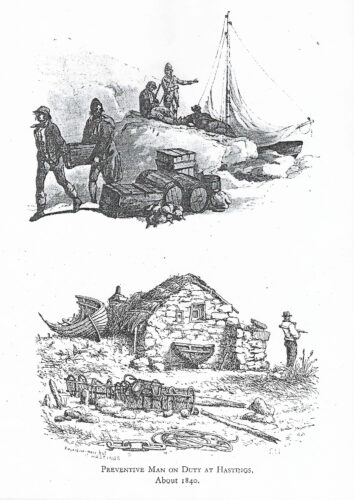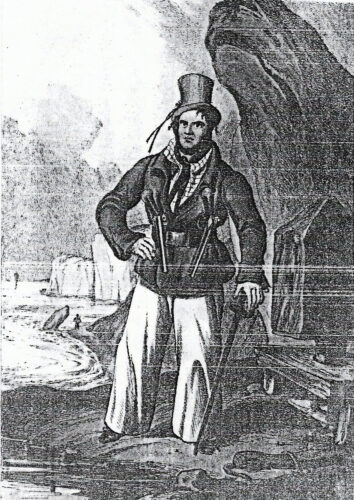Smuggling has been going on for centuries and will probably continue for as long as import duties exist. It was a regular trade in Sussex when the Normans invaded but it became more organised when the wool tax was levied in the 13th Century.
The free export of wool was forbidden and for the next 400 years much of the wool that was produced by the Southdown sheep was smuggled out of the country. Wool smuggling started initially on the Romney Marsh when the people exported the wool to the weavers of Flanders. By 1662 40,000 packs of wool were landed in Calais from Kent and Sussex alone.
 The wool smugglers were known as “Owlers” because they only worked at night and used the hoot of an owl as their signal. Their routes ran across the Ashdown Forest and further east through Lamberhurst. The Owl House at Lamberhurst got its name from its use as a posting house for these smugglers.
The wool smugglers were known as “Owlers” because they only worked at night and used the hoot of an owl as their signal. Their routes ran across the Ashdown Forest and further east through Lamberhurst. The Owl House at Lamberhurst got its name from its use as a posting house for these smugglers.
Towards the end of the 17th Century the demand for wool declined, but the smuggling fraternity discovered there were equal financial benefits in bringing contraband goods into the country. During the 18th Century smuggling was a major industry involving all classes, squire, parson, burgher and peasant. In these days before income tax the government levied heavy taxes on many necessities. A man could earn El a day ‘on the side’ (more than the weekly wage of an agricultural labourer) as a ‘runner’ carrying goods from the coast to the secret depots near London, and the housewife discovered that smuggling could keep down her rising housekeeping bills.
Silks, laces and tobacco were normally smuggled through ports such as Shoreham, Newhaven and Seaford while other items such as tea, brandy and wines were brought on to the beaches.
These items were much easier to handle than the bulky wool had been. Consignments of bullion were shipped across the Channel to France, which proved useful to the French Government in times of war, but was not very patriotic behaviour!
The contraband would be conveyed on the backs of men and ponies with muffled hooves. The men would be armed with pistols and wooden bats and always be on the look-out and listening for the preventative men. The punishment, if caught, would be the gallows or, if they were lucky, transportation.
There were many isolated landing places along this stretch of coast. The bays and beaches were mainly used but after 1817 the Coastal Blockade Force was reinforced and the smaller gangs used smaller gaps in the cliffs and left the larger bays to the gangs who had more men, sometimes hundreds, to fight off the blockade men. At times the numbers of smugglers were too large for the blockade force so all they could do was to stand and watch the smugglers escape. Hope Gap, just west of Cuckmere Haven was used as a landing place. Cuckmere Haven itself had a Watch House, which is still there today. It is the lowest house just downhill from the coastguard cottages. Cuckmere Haven was used to land goods which were carried through to Alfriston which had many hiding places for contraband. A footpath leads from Crowlink Manor to the sea where goods were landed. Crowlink, known by the locals as ‘Smugglers Bottom’, had a Watch House which has now gone. Goods were carried up the hollow lane to Crowlink Manor then on through the Oxen Dean to Jevington where they were hidden in the Eight Bells, Jevington Church and the Rectory cellars. Jevington Jigg and his gang were well known here.
Other landing places were Birling Gap, which was much more accessible than it is today owing to erosion, Cow Gap near The Meads, The Meads, Langney, Pevensey (The Red House there has seen many a battle), Normans Bay (known then as the Sluice and used by the Little Common Gang), Cooding Gate (Cooden), Veness Gap (South Cliff), and Sea Lane, now called Sea Road, Bexhill. The lower end of this lane was then marshy, the lane itself is sunken and it is said that there are many tunnels running under Bexhill’s Old Town with openings in cellars of houses, most of which are now bricked up. Glyne Gap, Bulverhithe (the most notorious of beaches), the area where Warrior Square, St. Leonards now is, the spot where the Queen Hotel at Hastings now stands, Ecclesbourne Glen, Covehurst Bay and the foot of the cliffs around Fairlight area were ideal as landing places. Goods were usually landed in a ‘dark’ (between moons) and were carried away on the backs of ponies and men. There were many hiding places in the cliffs in case of trouble, such as Robin Whiting’s hole in Ecclesbourne Glen and the western part of Galley Hill about half way up behind a piece of rock. There were tub holes at Barnhorn Manor behind the huge chimney breast, at Whydown Farm behind a false wall and a tub hole was found at Sandhurst Farm in 1939. Smaller barrels of spirits could be dropped overboard to be concealed in the muddy waters.
Hollow Ways. Some remaining fragments of the Hollow Ways still bear the name ‘Hollow Lane’. These narrow and little used roads are sunk deep between high hedgerows and, inland, are usually through woodland. Not originally smugglers’ tcuackways, these old routes used by the smugglers ran from lonely places on the coast across the marshlands, through the weald to the lonely parts of Ashdown.
It has been estimated that in the 18th Century no duty had been paid on two thirds of the tobacco consumed in England; nearly four million gallons of gin distilled in Holland were smuggled here and five to six pounds of tea came from France.
Smuggling activities between Seaford and Fairlight.
The stretch of coastline between Seaford and Fairlight was notorious for smugglers. On moonless nights muffled oars rippled the waters of inlets and creeks while inland hiding places were prepared in the cellars of inns, the secret passages and priest holes of county mansions, in churchyard tombs and vaulted mediaeval sewers.
Stomach warmer, often used by smugglers for carrying spirits, concealed under their clothes. Two slots at each side carried a belt or string tied round the body.
The Customs Service
 The Customs Service has been in force for more than 1200 years. The earliest record dates to AD 742 when ships were paying Customs dues and it has continued through the centuries. Among many other duties the Customs Service has been heavily linked with smuggling, a romantic vision of moonlit coves, hidden caves, flashing lights and ponies laden with tea, brandy and tobacco. Up to the 17th century the collection of dues was rather haphazard but with the Restoration of Charles II in 1660 the Customs Service received a fresh impetus. Charles II appointed the Board of Customs in 1671 and the Board of Excise in 1683. He had a great personal interest in and knowledge of maritime matters and is considered the ‘Father’ of the Revenue Fleet. In the early 18th century Customs vessels were generally called sloops. In the first half of the 19th century a private shipyard, Ransom and Ridley of Hastings were building revenue cutters for the Customs Board. One of their ships, the ‘Prince George’ was built in 1832 and was the only one to be launched by royalty.
The Customs Service has been in force for more than 1200 years. The earliest record dates to AD 742 when ships were paying Customs dues and it has continued through the centuries. Among many other duties the Customs Service has been heavily linked with smuggling, a romantic vision of moonlit coves, hidden caves, flashing lights and ponies laden with tea, brandy and tobacco. Up to the 17th century the collection of dues was rather haphazard but with the Restoration of Charles II in 1660 the Customs Service received a fresh impetus. Charles II appointed the Board of Customs in 1671 and the Board of Excise in 1683. He had a great personal interest in and knowledge of maritime matters and is considered the ‘Father’ of the Revenue Fleet. In the early 18th century Customs vessels were generally called sloops. In the first half of the 19th century a private shipyard, Ransom and Ridley of Hastings were building revenue cutters for the Customs Board. One of their ships, the ‘Prince George’ was built in 1832 and was the only one to be launched by royalty.
Preventive stations were built along the coast, the forerunners of the Coastguard stations and cottages. In 1818 the Coastal Blockade Service covered the area from Sheerness to Seaford and in 1831 the Coastguard Service replaced the Coast Blockade in Kent and Sussex.
Although the control of smuggling today is a relatively small part of the work of the Customs Service compared with the heyday of smuggling, it is still a very important aspect of the department’s responsiblilities especially in connection with the control of drugs.
For a study of the Customs Service in great detail the following book is highly recommended:
Kings Cutters – The Revenue Service and the War against Smuggling by Graham Smith
Smugglers Shoehorse
A shoe intended to be worn over the normal type. Only six of the nail holes were used; the other ‘nails’ were calkins welded on deliberately to deceive trackers. The imprint gave the impression that the horse was going in the opposite direction.
A Smugglers Song
From Puck of Pook’s Hill by RUDYARD KIPLING
If you wake at midnight, and hear a horse’s feet,
Don’t go drawing back the blind, or looking in the street,
Them that ask no questions isn’t told a lie,
Watch the wall, my darling, while the Gentlemen go by!
Five and twenty ponies
Trotting through the dark –
Brandy for the Parson, ‘
Baccy for the Clerk;
Laces for a lady, letters for a spy,
And watch the wall my darling, while the Gentlemen go by!
***********************
Running round the woodlump, if you chance to find
Little barrels, roped and tarred, all full of brandy-wine
Don’t you shout to come and look, nor use. ’em for your play
Put the brushwood back again – and they’ll be gone next day!
* ************************
If you see the stable door setting open wide;
If you see a tired horse lying down inside;
If your mother mends a coat cut about and tore;
If the lining’s wet and warm – don’t you ask no more
*************************
If you meet King George’s men, dressed in blue and red,
You be careful what you say, and mindful what is said.
If they call you “pretty maid”, and chuck you ‘neath the chin,
Don’t you tell where no one is, nor yet where no one’s been!
*************************
Knocks and footsteps round the house – whistles after dark –
You’ve no call for running out till the house-dogs bark.
Trusty’s here and Pincher’s here, and see how dumb they lie –
They don’t fret to follow when the Gentlemen go by!
*************************
If you do as you’ve been told, ‘likely there’s a chance,
You’ll be give a dainty doll, all the way from France,
with a cap of Valenciennes, and a velvet hood –
A present from the Gentlemen, along o’ being good!
*************************
Five and twenty ponies
Trotting through the dark –
Brandy for the Parson ;
Baccy for the Clerk
Them that asks no questions isn’t told no lie –
Watch the wall, my darling, while the Gentlemen go by!

